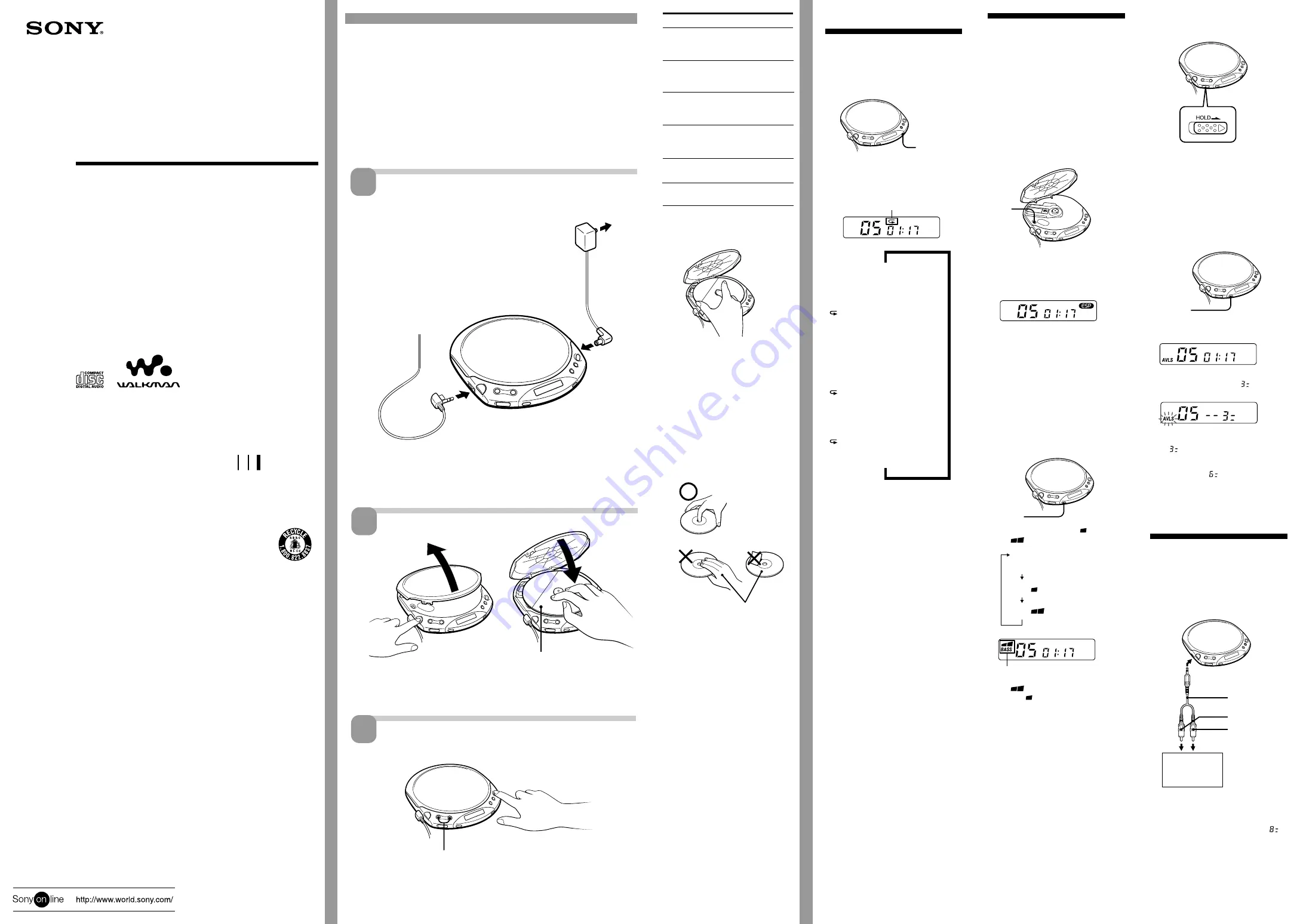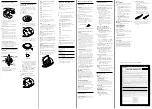
Portable
CD Player
Sony Corporation ©2000 Printed in China
Operating Instructions
About area code
The area code of the player you purchased is shown on upper left of the bar
code label on the package.
For accessories supplied with your player, check the area code of your model
and refer to “Supplied accessories” toward the end of this manual.
3-227-576-72 (1)
D-E225
Playing a CD right
away!
If you want to play a CD right now, choose to use your CD player on
house current. Other choices are the following three: rechargeable
batteries, dry batteries (see “Power Sources” on the reverse side) and car
battery.
Connect
1
1
Press OPEN to open the lid.
OPEN
For models supplied with the remote control
• Connect the plug of the headphones/earphones to the remote control.
• Connect the headphones/earphones to the remote control firmly. A loose connection may
cause noise during playback.
Place a CD
2
Adjust the volume.
2
Fit the CD to the pivot.
3
Close the lid.
2
Label side up
Not these ways
Press
.
once
.
repeatedly
>
N
once
>
N
repeatedly
Hold down
>
N
Hold down
.
* AMS = Automatic Music Sensor
To remove the CD
Remove the CD while pressing the pivot.
Notes on display
• When you press
>
N
, the total number of
tracks in the CD and the total playing time
appear.
• During play, the track number and the
elapsed playing time of the current track
appear.
Notes on handling CDs
• To keep the CD clean, handle it by its edge.
Do not touch the surface.
• Do not stick paper or tape onto the CD.
• Do not expose the CD to direct sunlight or
heat sources such as hot air ducts. Do not
leave the CD in a car parked under direct
sunlight.
About CD-Rs
This CD player is compatible with CD-Rs
but playback capability may vary
depending on the quality of the disc, the
recording device and application software.
To
Find the beginning
of the current track
(AMS*)
Find the beginning
of previous tracks
(AMS)
Find the beginning
of the next track
(AMS)
Find the beginning
of succeeding
tracks (AMS)
Go forward
quickly
Go backwards
quickly
B
Other Operations
Selecting play mode
You can enjoy the following five play modes:
“Normal play”, “Repeat play — all the
tracks”, “Single track play”, “Repeat play —
a single track” and “Repeat shuffle play”.
Press MENU during play.
Each time you press the button, the play
mode indication in the display changes as
follows:
No indication (Normal play)
The player plays all the tracks on the CD
once.
“
” (Repeat play — all the tracks)*
The player plays all the tracks on the CD
repeatedly.
“1” (Single track play)
The player plays a single track you’ve
selected once.
“
1” (Repeat play — a single
track)
The player plays a single track you’ve
selected repeatedly.
“
SHUF” (Repeat shuffle play)
The player plays all the track on the CD
in random order repeatedly.
* During Repeat play, you can locate the first
track after the last track by pressing
>
N
repeatedly. You can also locate the last track
after first track by pressing
.
repeatedly.
Play mode indication
m
m
m
m
MENU
m
Using other functions
To maximize the skip protection
performance (ESP MAX)
The typical ESP (Electronic Shock Protection)
function minimizes skipping by using a
buffer memory that stores music data and
plays it back in the event of a shock.
The ESP MAX system is an extremely
sophisticated technology. Due to the light
weight and improved anti-shock
characteristics of the optical block, this system
recovers from the skipping much quicker
than conventional technology such as ESP or
ESP
2
.*
* Although ESP MAX provides excellent
protection, skipping may occasionally occur.
Set ESP to “ON.”
The ESP indication appears.
To release the ESP MAX function, set ESP to
“OFF.”
Notes
• Playing may stop when the CD player gets a
strong shock even with the ESP MAX function
on.
• You may hear a noise or sound may skip:
— when listening to a dirty or scratched CD,
— when listening to an audio test CD,
— when the player receives continuous shock or
— when using poor-quality CD-Rs or if there is
a problem with the recording device or
application software.
To enjoy more powerful bass sound
(Digital MEGA BASS)
You can emphasize the bass-boosted sound.
Press SOUND to select “BASS
” or
“BASS
.”
“BASS
” enhances the bass sound more
than “BASS
.”
Note
• If the sound is distorted when using the
SOUND function, turn down the volume.
m
m
m
ESP
To lock the buttons
You can lock your CD player against any
accidental operations.
Slide HOLD in the direction of the arrow.
When you press any button, “
Hold
” appears
in the display and you cannot operate the CD
player.
To unlock, slide HOLD in the opposite
direction of the arrow.
To protect your hearing (AVLS)
The AVLS (Automatic Volume Limiter
System) function keeps down the maximum
volume to protect your ears.
Hold down SOUND until “AVLS” appears in
the display.
If you turn up the volume to “
*”, you
cannot turn up the volume any more.
If you want to turn up the volume to more
than “
*”, hold down SOUND until
“AVLS” disappears from the display.
* For the customers in France
This level is set to “
.”
Note
• If you use the sound function and the AVLS
function at the same time, sound may be
distorted. If this happens, turn down the
volume.
Connecting to other
stereo equipment
You can listen to the CD through other stereo
equipment or record a CD on a cassette tape.
Refer to the instruction manual of the other
equipment for details. Before making
connections, turn off each piece of equipment.
Notes
• Before you play the CD, turn down the volume
of the connected equipment so as not to
damage the connected speakers.
• If you turn up the volume to more than “
”,
the sound may be distorted.
LINE IN or
REC IN
Continue to the reverse side
c
Stereo system,
cassette recorder,
radio cassette
recorder, etc.
Play
3
To stop play, press
x
/CHG.
CAUTION
The use of optical instruments with this
product will increase eye hazard.
Owner’s Record
The model and the serial numbers are located
at the rear. Record the serial number in the
space provided below. Refer to these
numbers whenever you call upon your Sony
dealer regarding this product.
Model No. D-E225
Serial No. ___________________
Certain countries may regulate disposal of the
battery used to power this product. Please
consult with your local authority.
For the customers in the USA
This equipment has been tested and found to
comply with the limits for a Class B digital
device, pursuant to Part 15 of the FCC Rules.
These limits are designed to provide reasonable
protection against harmful interference in a
residential installation. This equipment
generates, uses, and can radiate radio frequency
energy and, if not installed and used in
accordance with the instructions, may cause
harmful interference to radio communications.
However, there is no guarantee that interference
will not occur in a particular installation. If this
equipment does cause harmful interference to
radio or television reception, which can be
determined by turning the equipment off and on,
the user is encouraged to try to correct the
interference by one or more of the following
measures:
– Reorient or relocate the receiving antenna.
– Increase the separation between the equipment
and receiver.
– Connect the equipment into an outlet on a
circuit different from that to which the receiver
is connected.
– Consult the dealer or an experienced radio/TV
technician for help.
You are cautioned that any changes or
modifications not expressly approved in this
manual could void your authority to operate this
equipment.
AC power adaptor
DC IN 4.5 V
i
Headphones
to an AC
outlet
1
Press
>
N
.
SOUND
The selected sound mode is displayed.
BASS
BASS
No indication
(Normal play)
SOUND
Left (white)
Right (red)
Connecting cord
i
For the customers in the USA and
Canada
This mark is available in the USA
and Canada only
RECYCLING NICKEL-CADMIUM
BATTERIES
Nickel-Cadmium batteries are
recyclable. You can help preserve
our environment by returning your
unwanted batteries to your nearest
point for collection, recycling or
proper disposal.
Note:
In some areas the disposal of nickel-
cadmium batteries in household or business
trash may be prohibited.
RBRC (Rechargeable Battery Recycling
Corporation) advises you about spent battery
collection by the following phone number.
Call toll free number: 1-800-822-
8837 (United States and Canada
only)
Caution:
Do not handle damaged or leaking
nickel-cadmium batteries.
For the customers in the USA and
Canada
DISPOSAL OF NICKEL METAL
HYDRIDE BATTERY.
NICKEL METAL HYDRIDE BATTERY.
DISPOSE OF PROPERLY.
You can return your unwanted nickel metal
hydride batteries to your nearest Sony Service
Center or Factory Service Center.
Note:
In some areas the disposal of nickel metal
hydride batteries in household or business
trash may be prohibited.
For the Sony Service Center nearest you call
1-800-222-SONY (United States only)
For the Sony Factory Service Center nearest you
call 416-499-SONY (Canada only)
Caution:
Do not handle damaged or leaking
nickel metal hydride battery.


